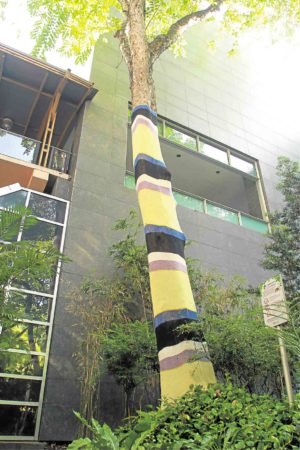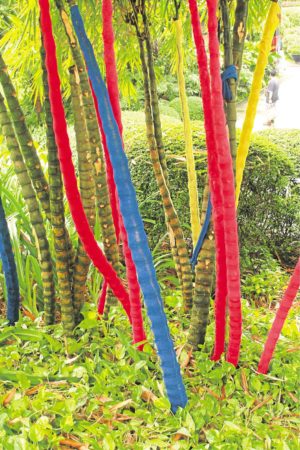
The Greenbelt garden exploded with color recently, thanks to knitwear designer-turned-“yarn bomber” Lulu Tan-Gan.
Over the past 15 years, yarn bombing has become a worldwide trend, wherein traditional crafts such as knitting and crocheting have replaced graffiti in the urbanscape. Yarn bombers cover potholes, public monuments, motorcycles, tree trunks, parking meters and even bridges. The pairing of fuzzy and bold-colored knits with industrial surfaces has injected fun and a sense of community into an impersonal setting.
Paying tribute to Tan-Gan’s contribution to Philippine fashion and reviving handicrafts, the Ayala Museum is holding the “Yarn Bomb, Knit Bomb” exhibit.
Tan-Gan wrapped public objects in knits and crochet—trees, including poles and garden ornaments around Greenbelt garden, such as the antique cannon and stone grinders on the pond.
The exhibit is a collaboration between Tan-Gan and fashion design students of the College of Saint Benilde and Ayala Museum, who crowdsourced from crochet hobbyists.

Tan-Gan chose a retro theme to evoke the nostalgia of knitting and crocheting. The color palette is evocative of Pop Art of the ’60s, while the blocking of bold hues is reminiscent of Yves Saint Laurent’s Mondrian collection.
Crocheted by hobbyists
The main tree is an assemblage of big and small circles crocheted by hobbyists.
The fashion students were tasked to yarn-bomb a tree in natural colors. They knitted the ecru and beige fabrics in school and combined them with organic materials.
“Working with a neutral color scheme, the students become sensitive to textures,” says the designer, referring to the composite of raffia, yarn, ribbon, rope and scraps of piña that have been collected by Tan-Gan in the past decade.
She explains that the exhibit celebrates Slow Fashion, a movement that encourages taking time for quality, albeit labor-intensive production, giving soul to the product, and connecting to the environment.
Tan-Gan walks her talk. She doesn’t do shortcuts. Her design philosophy is based on the in-depth study of material and technology as the basis of original design.

When she started her career three decades ago, she set herself apart by creating a niche in knitwear. However, the public never knew that her clothing was produced in handlooms with low carbon footprints.
“I felt I could produce designs if I started designing my materials. People only value the surface treatment. They appreciate the knit, but aren’t interested in knowing how it is done,” she says.
After graduating from fine arts at the University of Santo Tomas, she took up construction techniques at the Madonna School of Fashion.
When Boutique Square, a floor dedicated to Filipino designers, opened at ShoeMart Makati, Tan-Gan couldn’t get in due to stiff competition. She worked as a buyer and merchandiser. Her mentor was Teresita Sy-Coson, who led the store’s development.
On buying trips with Coson, Tan-Gan longed for the convenience of wrinkle-proof and wash-and-wear clothes.
“I was career-oriented. I wanted to wear materials that were user-friendly. I had to look for quality fiber content,” she recalls.
In the late ’70s and early ’80s, knits meant frumpy sweaters and cardigans. Tan-Gan started experimenting with knits. Eventually, she bought a handloom and knitted the fabrics herself.
Finally finding an opening for a designer, she started producing knits under the ShoeMart label Elle. In 1983, the Center for International Trade and Export Missions sent Filipino designers to Paris to promote the country, but none of the designers wanted to risk taking volume orders.
Exporting
Tan-Gan bravely accepted a Japanese buyer’s order, bought more looms and eventually began exporting to Europe and North America, selling export overruns from her home.
Coson discovered Tan-Gan’s enterprise and asked her to launch her eponymous label at Boutique Square. She had since changed the market’s perception of knits.
Tan-Gan’s atelier grew to 30 looms to meet volume orders. At the height of the brownouts, work continued, since the looms were manually operated.
The export business flourished until the early 2000s, when China invaded the world market. Most buyers placed orders in China due to cheaper costs.
Today, Tan-Gan limits the business to her boutique at Greenbelt 5, and works with subcontractors.
Ten years ago, she ventured into pineapple fabrics or piña with the vision of making the garments more accessible to the public. The materials are produced in Aklan. Because of the limited yardage, Tan-Gan has disciplined herself to design with minimal wastage. Over the years, she has accumulated only four sacks of retazo, which are being repurposed on Greenbelt trees.
Then CSB SDA Dean Joey Yupangco invited her to teach in the fashion department. With her experience in design and business savvy, Tan-Gan took it upon herself to make the curriculum more relevant.
As former chairperson of the CSB School of Design and Arts’ fashion department, Tan-Gan has been underscoring the importance of in-depth study of materials and technology as the basis for design.
“When I first joined the school, most of the students referred to magazines for pegs. The design process starts with designing the material. When you start from scratch, you are able to discover your identity,” she explains.
The designer is working on a syllabus for knitwear design for a new generation of knitwear designers. The pattern for a garment or fabric is a mathematical matrix. “Knitting is a way of construction. When you keep working on your tools, you will find something new.” —CONTRIBUTED












































